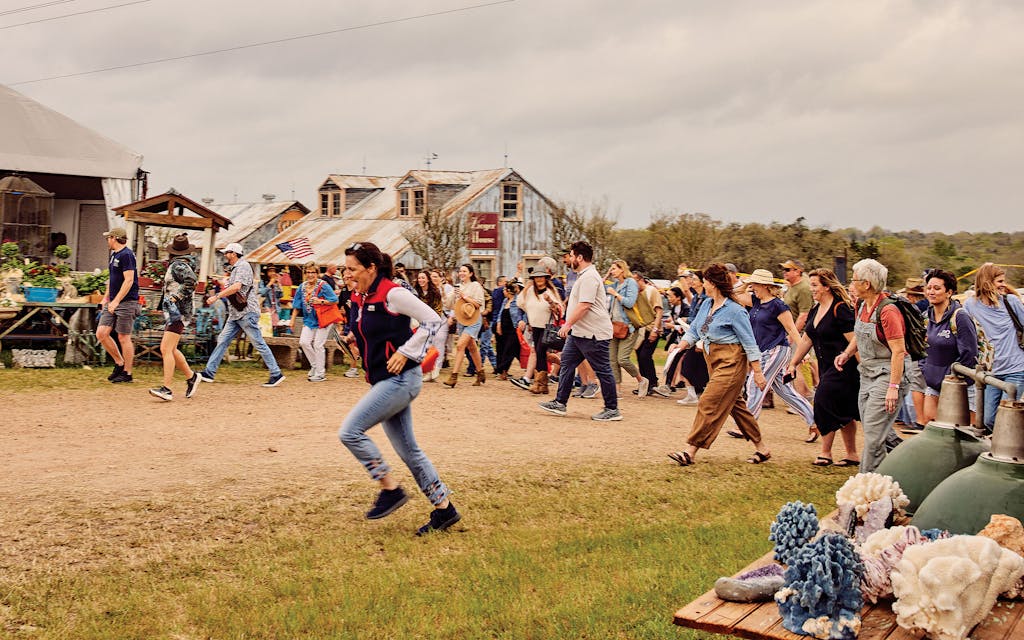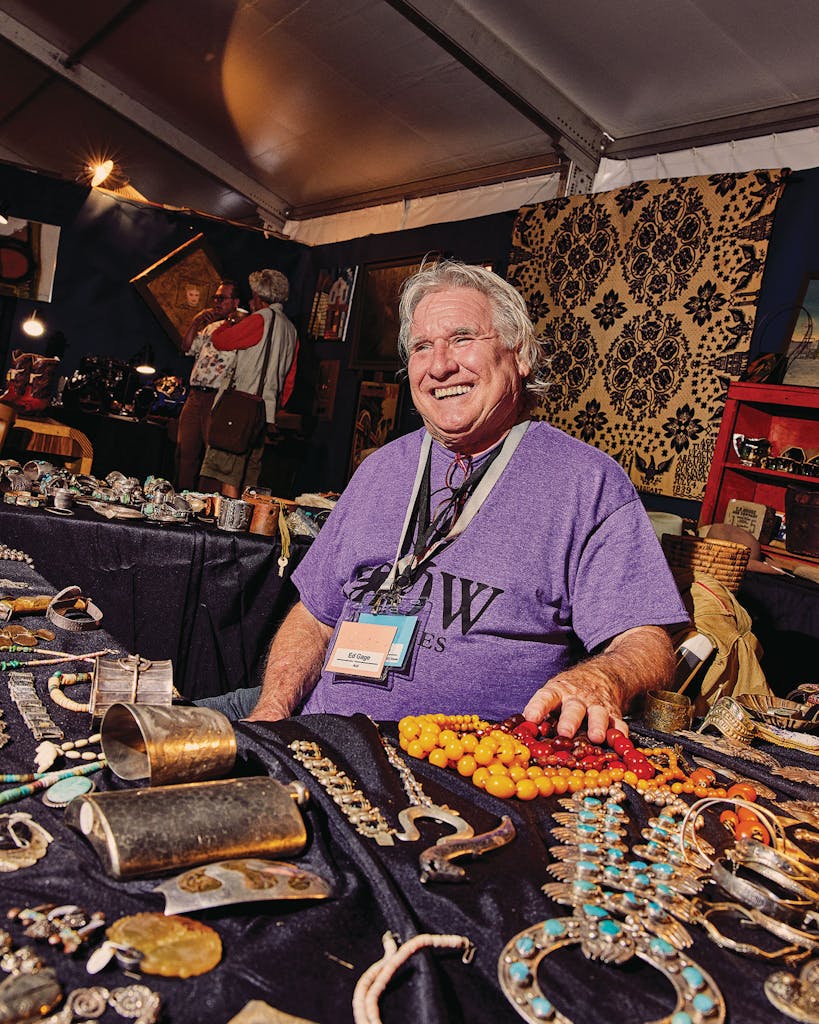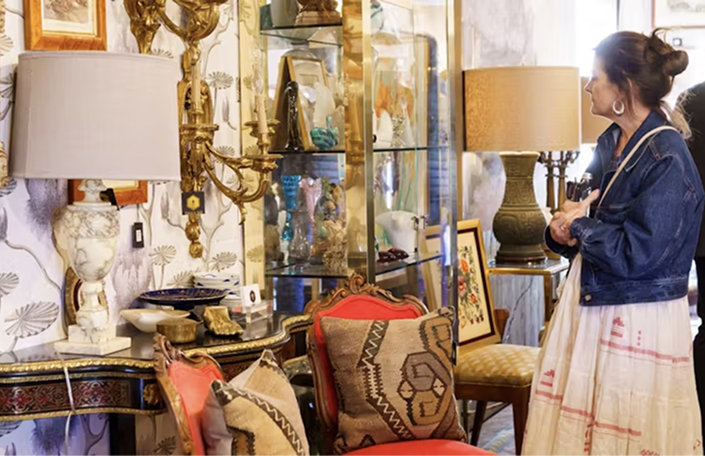Texas Monthly | How Round Top Became a Whole Vibe
Celebrities, influencers, and high-end shoppers are among the throngs that descend upon the tiny town’s biannual antiques fair, which has flourished—even during a pandemic.
By Katy Vine
When I arrived in Round Top, locals warned me that the opening day of the Marburger Farm Antique Show looked like Spain’s running of the bulls. Improbable as this sounded to me, it was an apt comparison. As soon as the metal triangle rang out at 9 a.m. on the last Tuesday in March, hundreds of fidgety shoppers ducked under the yellow caution tape and beat a path toward the market’s buildings and commercial tents—five as large as a football field. Those too self-conscious to break into a gallop awkwardly power walked as if their names had just been called from the stage at the Oscars. The experienced professionals were easy to spot in the surging crowd: they moved in like a SWAT team with their assistants, headsets, clipboards, and “sold” stickers.
Ann Marie Scichili might have stood out regardless. The founder of Dallas’s AMS Design wore silver Gucci tennies, black pants, two button-down shirts, wood-bead necklaces, and oversized cinnamon-framed glasses; she carried a Gucci bag adorned with a patch illustration of Disney’s Three Little Pigs, and a white cowboy hat topped her bald pate (she has alopecia). Her conversational style is as mixed as her attire—she can end a discussion on the differences between Christofle and Waterford crystal with a “See you later, alligator.”

The moment the triangle rang, Scichili and two employees beelined to the Sodium Bulb Antiques booth, filled with art deco and other early twentieth-century finds, where proprietor Scott Wilson was bouncing on the balls of his feet. Looking to furnish projects for her big-name clients—including the New York Islanders owner’s suite at UBS Arena and a hotel restaurant in Oceanside, California—she immediately homed in on a polished aluminum Cutler mail chute from the early thirties. “That sets a room,” she said. “That’s a whole direction.”
“That is one of a kind,” Wilson agreed, adding that Cutler had made similar chutes for the Empire State Building. Scichili went around the booth, pointing her right index finger at anything that caught her eye and announcing a purchase every thirty seconds or so:
I’ll take the letter box.
The bookshelf.
The salt and pepper shakers.
The candlestick.
The chairs.
The wall sconces.
Eight minutes after arriving, she had already bought sixteen items. As her assistants finished the sale, she moved on to a nearby stall, pointing and buying with the same urgency. “This booth will be sold out in the next hour,” she explained to me.
Marburger, which marks its twenty-fifth anniversary this year, is one of the most popular attractions during the two-week spectacle of antiques shows—often referred to as the Super Bowl of design—that materializes in Round Top every spring and fall. What started in 1968 as a modest event in this hamlet about halfway between Houston and Austin has become one of the largest antiques fairs in the U.S. Because no single entity oversees the roughly four thousand vendors, there’s no official name, but one of the common monikers for it is the Round Top Antiques Show. Some call it Texas Antiques Week (although it spans eighteen days in both the spring and fall) or just Round Top (even though it extends to nearby towns, most notably Warrenton). In a town with about ninety residents, the temporary population increase over the show’s run is about a gazillion percent. The showcase brings in at least 150,000 shoppers twice a year, and some vendors host a condensed four-day winter show in January.
Novices to the event—the fall dates are October 13 to 30—might want to take a deep breath and clutch their directory maps as they head south from U.S. 290 and the tableau comes into view on the horizon: more than twenty miles of sprawling markets along two-lane Texas Highway 237. In Round Top, they’ll find curated, high-end retailers in tents and existing buildings such as event centers and dance halls. Many have pastoral names that conjure up a whiff of lavender: Blue Hills, the Halles, Market Hill. Most are open for the entire event, although a few, including Marburger, are in business for just a few days. Keep heading south to Warrenton, and the fields become populated with trailers and more tents. In this area, which some refer to as the “flea market,” vendors hawk vintage store signs, Mexican pots, mirrors, movie posters, Hawaiian shirts, whirligigs, and other generally less expensive miscellany. At a section called Dead Peoples Stuff, the motto “You Die, We Buy” applies to everything from doll heads to hubcaps.
Although the event has long drawn all kinds of shoppers—from bargain hunters to scrupulous professionals—Round Top has taken on a more elevated vibe over the past few years, and vendors have been reporting their highest sales numbers, despite the pandemic. Rather than wait out bumper-to-bumper traffic, a few shoppers are flying in on helicopters. And while many patrons come into town for a single, strategic strike, lugging rusty wagons in search of that vendor who specializes in oilcan collections or tiny bottles, others linger for days. Some of these leisurely shoppers arrange for their newly purchased framed paintings and mid-century modern lamps to be shipped back home while they stay at nearby places such as Rancho Pillow, a five-year-old motel compound just outside town that hosts a dinner series, Feasts in the Field, catered by notable chefs during market days.
“There was buzz three years ago that it was becoming the Hamptons of Houston.”
Locals and longtime regulars say they’ve witnessed a significant increase in the event’s size and exposure. The fertile pastures have sprouted more temporary showrooms and high-end markets, as well as boutique hotels and year-round stores that are capitalizing on the fair’s renown. Real estate prices are soaring. Big-name customers such as Texas-based hotelier Liz Lambert, sought-after interior designer Kelly Wearstler, and Waco moguls Chip and Joanna Gaines have come to rely on Round Top to help furnish high-end residences, hotels, and other projects around the country. Designers visit from Pottery Barn, Forever 21, and Ralph Lauren to buy store decor and to get design ideas. In their wake have come celebrities such as singer Gwen Stefani, actors Adrian Grenier and Matthew McConaughey, and CNN anchor Anderson Cooper.
Round Top has evolved: it’s no longer simply a place to go treasure hunting; it’s a place to be Instagrammed, a host city for a girls’ trip, a market with global design influence. Some locals aren’t too happy with this natural maturation—with changes come the predictable eye rolls. Hard-core junkers have grown uneasy about the shift toward high-end, demanding customers and the accompanying restaurants and hotels that cater to them. “It’s becoming over-the-top bougie,” said one vendor. “There was buzz three years ago that it was becoming the Hamptons of Houston.”
Round Top’s first big antiques show opened 54 years ago not just to draw tourists but to distract them. Ima Hogg, Faith Bybee, and Hazel Ledbetter—all wealthy Texans—were buying, restoring, and preserving historic homes and buildings in the area, many built by German settlers in the nineteenth century, turning some of them into weekend retreats to escape the big cities. These restoration projects drew the attention of curious onlookers who wanted to see their antiques and decor. Ledbetter approached esteemed Houston antiques dealer and fellow society insider Emma Lee Turney about starting an antiques show. According to Turney’s book Denim and Diamonds: The Story of Emma Lee Turney’s Round Top Antiques Fair, coauthored by Beverly Harris, Hazel “asked Emma Lee to establish a good antiques show in Round Top so that, as she put it, ‘the public would quit peeking in our windows to see what we’re doing up here.’ ” Using this as an opportunity to highlight Texana and Americana pieces, Turney accepted the challenge.
A tenacious businesswoman with shoulder-length hair curled girlishly at the ends, Turney was, by all accounts, a force. Determined to find just the right location for the fair, she took particular interest in the home of the Round Top Schützen Verein, a traditional German-style shooting society, with a freestanding peaked roof and a high ceiling. She was smitten. She repurposed the Schützen Verein for two days and ushered in 22 vendors hauling dollies of fine American antiques—quilts, South Louisiana cypress furniture, Native American pottery—for the first Round Top Antiques Fair, in October 1968. It was such a success that she soon turned it into a biannual show and continued to expand it over the next few decades, adding more vendors and space. (It’s now located at the Big Red Barn Event Center.)
Turney had high standards for dealers’ merchandise, which she enforced with a brusqueness that divided sellers into one of two camps: pro- and anti-Turney. Even after half a century, longtime dealers will sometimes mention which group they fall into. A pro-Turney dealer I spoke with said, “Her concept was generally correct,” conceding that “her delivery sucked.”

One vendor, Ed Gage, considered himself solidly in the anti-Turney camp. Gage is a round man with a thick tuft of white hair, a talkative flirt who calls every woman “darlin’ ” and rarely finishes a thought without interrupting himself. He is seventy years old, a number he finds impossibly high. (“I’m still twelve, if that makes any sense,” he told me.) He cofounded Austin’s Uncommon Objects antiques store in 1991 and ran it until around 1995. That’s when he looked east, where Turney’s show was pulling in large crowds.
Looking for a place to sell quilts, Gage and a business partner, John Sauls, bought 44 acres and in 1997 announced a “dealer-friendly” antiques show, one that didn’t have as many restrictions as Turney’s market on what antiques could be sold. They named theirs for the property’s resident, Leona Marburger (she died in 2010, at age 105). Turney was unamused by the competition. “She threatened to sue us on our opening day,” Gage recalled. When she found no legal standing to do so, she prohibited her vendors from going anywhere near the Marburger show—though some of them, clad in disguises, would sneak in to shop anyway, doing their best to avoid being busted by Turney’s spotters, who were scouring the premises.
The higher-priced items, Dooley noted, were selling fastest. He wasn’t sure why.
Marburger was just the beginning of an organic evolution. New vendors started importing shipping containers of merchandise from Asia and Europe, expanding the event’s original focus on Americana. Warehouses and showrooms sprouted up seemingly overnight. Eventually, attendees started noticing more bathrooms, more air-conditioned venues, more food offerings beyond the initial shopper’s diet of popcorn, barbecue, and fried pies. Around 2000, Janie Sikes and her daughter Amie began selling vintage finds at a booth under the name Junk Gypsy. Another daughter, Jolie, joined them a few years later, and together they created a secondhand boho empire that has spawned a reality TV show, a Round Top store, and an adjacent hotel, the Wander Inn.
Gage sold his portion of Marburger to Sauls in 2002, and, after several attempts at reinvention, booms and busts, he is back working at a booth at Marburger and helping management as an authenticity adviser—or, as he puts it, he’s “the jerk with the clipboard.” In 2005 Turney sold her show, now called the Original Round Top Antiques Fair, to dealer Susan Franks, though she remained a blunt critic to the end. A few years before Turney died, in 2021, at age 92, my former colleague Jordan Breal asked her what she thought of the miles-long evolution of her brainchild. “Well, not much,” Turney replied.
Despite Round Top’s increasingly cosmopolitan draw, many event veterans believe that its true heart is composed of the nomad vendors, who arrive at the makeshift campgrounds in RVs, prepared with receipt books, several pairs of comfortable shoes, and shipping containers packed with goods. A lot of them head to the eclectic Warrenton fields—known as just “the fields”—which cover three miles along Highway 237. They are where a seller might be situated in tents between an ex-con and a practicing dentist with a vintage side hustle, a place where a veteran dealer might come across an item she loves only to find out that she had sold that very object to this vendor years ago.
Whether vendors work in a tent or other temporary setup (the show dealers) or a brick-and-mortar store (the shop dealers), they have to measure up: those who do well are those who can best estimate a rare find’s worth, gauge the appetite of the marketplace, organize displays to maximize visual appeal, or start a trend. But there are significant cultural differences between show dealers and shop dealers. “Show dealers are the most dysfunctional functional people you’ll ever meet,” said Mark Dooley, who proudly identifies as one himself. “The pandemic wasn’t much of an issue for us because we thrive in chaos. It’s more a free-spirit mind, less business calculations.”
One day during the spring show, I followed Dooley, an effort that required more exercise than I’d anticipated. A former extreme-sports enthusiast and Army paratrooper with perma-tanned skin, a ponytail, and a charismatic scowl, he has worked the Warrenton fields since 1996 and now owns two sections, called Excess 1 and Excess 2, most of which he rents out to other wholesalers and retailers. Though some consider him contentious (he used to hand out business cards to difficult customers that said, simply, “Go away”), his sections are among the most popular in the area. Walking at a brisk pace, fueled by cigarettes and Monster Energy drinks, he responded to pricing questions at his own showroom, North Star Antiques, as none of his merchandise was marked.
One woman pointed to a metal sculpture that looked like a model for an atom. “I like the coatrack. How much for that one?”
“That’s my last Roger Feraud, and I’d do two hundred seventy-five,” Dooley told her. “We had sixteen of those. They’re five hundred to seven hundred fifty dollars retail.”
When customers asked how he knew the prices, he’d say, “I have a good memory,” and if he noticed a suspicious look in response, he’d launch into the background on the piece: where it was from, what it was used for, and how much it had cost him, adding, “I don’t haggle.”
Like many of the Round Top nomad vendors, Dooley used to travel to other shows across the country, once hitting 53 in a single year. Many of them have been dying off thanks to online shopping, and these days, at age 52, he stays mostly at Excess. “Round Top is thriving in spite of the decline of all these other shows,” he said. He believes that Round Top benefits from its massive size and its variety of antiques: “everything from true flea market trash to seventy-thousand-dollar commodes.”
By 2 p.m., he was beaming. He’d already sold the most expensive item he had on hand, a pair of vintage “true shearling” sheepskin chairs for $22,000, as well as $57,000 worth of goods to another vendor. The higher-priced items, Dooley noted, were selling fastest. He wasn’t sure why.
Dooley was far from alone in pondering the reasons for Round Top’s mid-pandemic business boom. Over at Marburger, Gage was preparing for a big year at his booth. In the two years since the March 2020 show was canceled because of the COVID-19 shutdown, he said, he’d had the most lucrative shows of his career and didn’t see signs it was slowing. “I spent every last nickel to buy stock for this year,” he told me as he set up a display of turquoise jewelry. He speculated that looking at and buying beautiful things is healing for stressed-out customers.
Visitors really do look aglow, spellbound even, as if they’re kids at a theme park.
Other vendors reported similarly successful years but offered different theories. Some said supply chain issues helped dealers sell items that were difficult to find brand-new, especially furniture. Some guessed that housebound folks felt inspired to redecorate after spending hours on end looking at social media feeds of other people’s stunning homes. Perhaps some shoppers were searching for control over their environment, as if by finding the right style elements they could feng shui the pandemic out of our consciousness.
Because of these golden years, some shop owners have begun pressing for a year-round attraction instead of a biannual event. Dooley doesn’t know how he feels about that—he worries the showcase would lose some of its appeal if it were a permanent fixture. However, “I’m not against progress and the show getting bigger,” he said with a shrug. “Other venues have far more money than I do and have a grander idea of what it will be.”



